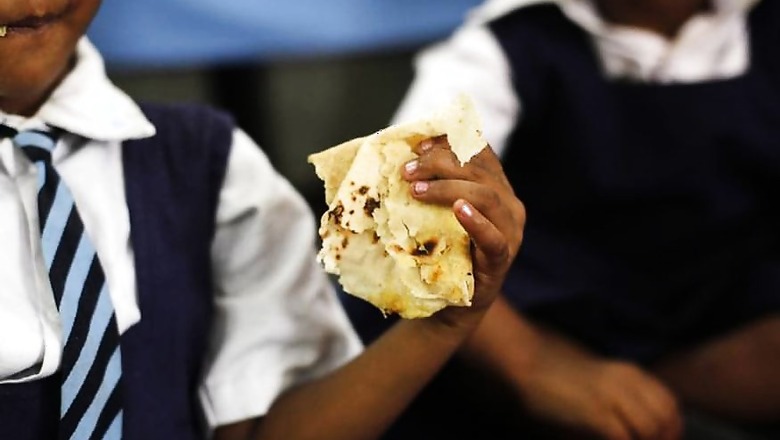
views
Shimla: Caste discrimination continues to leave a bad taste among students savouring their midday meals in almost every rural government school of Himachal Pradesh, a state where the literacy rate is at a high of 82.8 percent.
Lower caste students face social discrimination in all school activities, including partaking the midday meal. Even the chefs employed in 15,000-plus government schools for cooking meals are largely from the higher castes.
The latest instance of segregating Dalit students in a government school in Kullu district during a live telecast of Prime Minister Narendra Modi's programme has hogged the headlines.
But, claim social activists, that was not a stray incident.
They say centuries-old caste-based attitudes persist in almost every rural school despite India banning discrimination in 1955. The midday meal is a nationwide school programme of the Indian government to improve the nutritional status of school-age children.
Social activist Kuldeep Verma said caste-based discrimination during the serving of the midday meal is common in the state, more prominent in the extremely backward trans-Giri areas of Sirmaur district, and calls for dignity for the lower-caste community.
"You can visit any government school in the trans-Giri area and you will find separate queues for Dalit students during the midday meal. Even the head cook employed for preparing the meals is not from a lower caste," Verma, who runs the People's Action for People in Need (PAPN) NGO in Sirmaur, told IANS.
He said the students belonging to the higher castes are tutored by their parents against mingling with their peers belonging to the lower castes and to sit separately while in school.
Locals in the trans-Giri areas, mainly farmers cultivating ginger on small landholdings, have been fighting for decades to get the status of a Scheduled Tribe.
Himachal Pradesh has a population of over 6.8 million as per the Census for 2011, and Dalits comprise one-fourth of the state's population. It says more than 90 percent people live in rural areas — in 17,882 villages — of the total 20,690 revenue villages.
An optimistic Ashwani Kumar Thakur, Principal of the Government Senior Secondary School at Chikhar Satlai, one of the remotest schools located some 50 km from the state capital, told IANS they are educating the students about caste discrimination laws.
"We are sensitising our students so that they change their behaviour and attitudes, but at times we face strong resistance from village elders," Thakur told IANS.
As per the guidelines of state education authorities, each student is asked to sit as per his roll number during all school activities, Thakur added.
Article 15 of the Constitution bars discrimination on the basis of caste and laws are in place to penalise it.
But sociologists believe the practice persists in the state as the most marginalised communities, including Dalits, are often barred from public places in villages like temples and water taps. Often students in schools across the state refuse to eat the midday meal because it was cooked by a Dalit.
They say such oral traditions and cultures are often practised in those areas where there is a culture of "devta" or deity worship.
"Old Himachal" areas that lie in Shimla, Sirmaur, Kullu, Mandi, Kinnaur and Lahaul-Spiti districts are known for worshipping deities for centuries. Take the case of the picturesque Kullu Valley, where 534 gods and goddesses "live". They travel, play, get angry and demand penance. Each village or a cluster of hamlets has its own deity.
"Here in the land of gods, the devtas command and the people obey. The gods here are not idols enshrined in temples; they are alive," says a book compiled by the Kullu administration in 2014 after year-long research on local deities.
The book says the gods "live" with the people. They "speak" to their followers and tell them what to do. The conduit between the mortals and the deities are the "agur", the traditional shamans who form the core of the communities' spiritual sustenance. The agur mediates between the people and the gods.
Noted Shimla-based writer S.R. Harnot, who knocked on the state high court's door to end caste discrimination at a prominent Hindu temple near Bilaspur town, said the caste system is deeply entrenched in the state.
He said the "bajantris" (musicians) accompanying the deities largely belong to the lower castes.
"The bajantris can accompany the deity's palanquin but they are not allowed to touch it or sit with their fellow villagers during puja," Harnot told IANS.
"Discrimination on basis of caste is a striking reality. How can the state shirk its responsibility of creating a healthy society," asked Harnot, whose popular novel "Hidimb" brings to the fore the plight of suppressed people in the state's remote areas.
"The state must act pro-actively and begin the exercise in schools where a child learns his/her first lesson on the fundamental right to equality," he added.


















Comments
0 comment